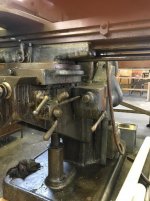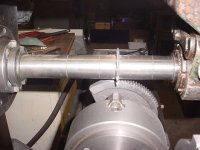Brandenberger
Hot Rolled
- Joined
- Sep 19, 2017
Hi,
I'm considering a B&S No2 "light" type mill. This is a universal from
1941. This is the type without the knee motor. Everything runs fine other
than the knee is very stiff-- the machine had been used for a single operation
for probably decades.
I am struggling to find a manual for this model (easy to find the newer type with the knee motor). I've found the parts manual on vintagemachinery for this type: http://vintagemachinery.org/pubs/2185/18326.pdf.
I've read some comments on PM that some of these versions had a purely mechanical rapid feed, but that it was an option?
This machine has two arbors, and an overarm support, and a full set of gears for driving the (missing) dividing head.



What do those of you that know these machines think of these "no knee motor" versions versus newer ones with the knee motor? If rapids aren't there this is understood.
I may have a chance at a newer B&S No2 light machine with the knee motor and rapids (but condition unknown), hence the question. In some B&S brochure I saw at least some marketing text that said the knee motor allowed them to simplify the design quite a bit.
I talked to Bourn and Koch and they warned the knee motors are totally obsoleted at this point but that they will still rewind them.
-Phil
I'm considering a B&S No2 "light" type mill. This is a universal from
1941. This is the type without the knee motor. Everything runs fine other
than the knee is very stiff-- the machine had been used for a single operation
for probably decades.
I am struggling to find a manual for this model (easy to find the newer type with the knee motor). I've found the parts manual on vintagemachinery for this type: http://vintagemachinery.org/pubs/2185/18326.pdf.
I've read some comments on PM that some of these versions had a purely mechanical rapid feed, but that it was an option?
This machine has two arbors, and an overarm support, and a full set of gears for driving the (missing) dividing head.



What do those of you that know these machines think of these "no knee motor" versions versus newer ones with the knee motor? If rapids aren't there this is understood.
I may have a chance at a newer B&S No2 light machine with the knee motor and rapids (but condition unknown), hence the question. In some B&S brochure I saw at least some marketing text that said the knee motor allowed them to simplify the design quite a bit.
I talked to Bourn and Koch and they warned the knee motors are totally obsoleted at this point but that they will still rewind them.
-Phil








